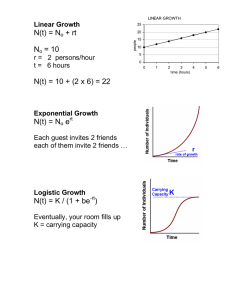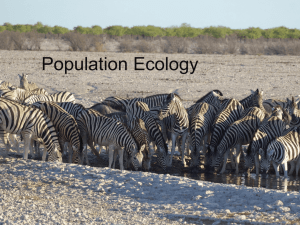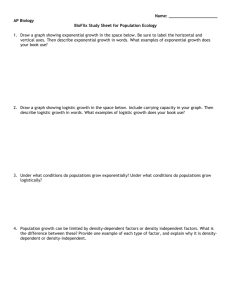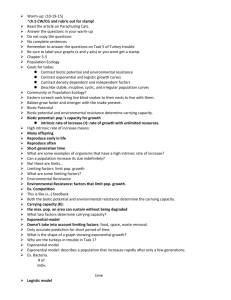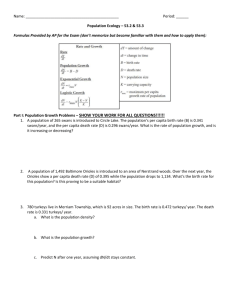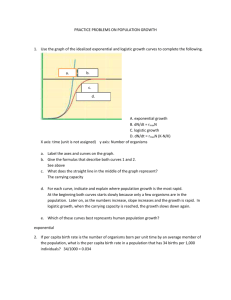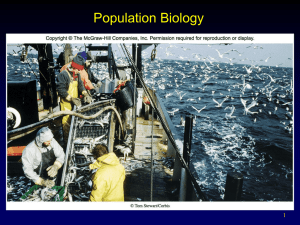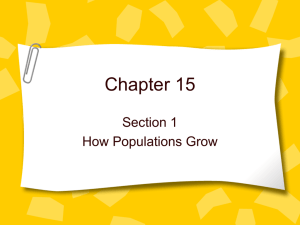Population Growth Pre-Assignment. 1. List five countries that you
advertisement
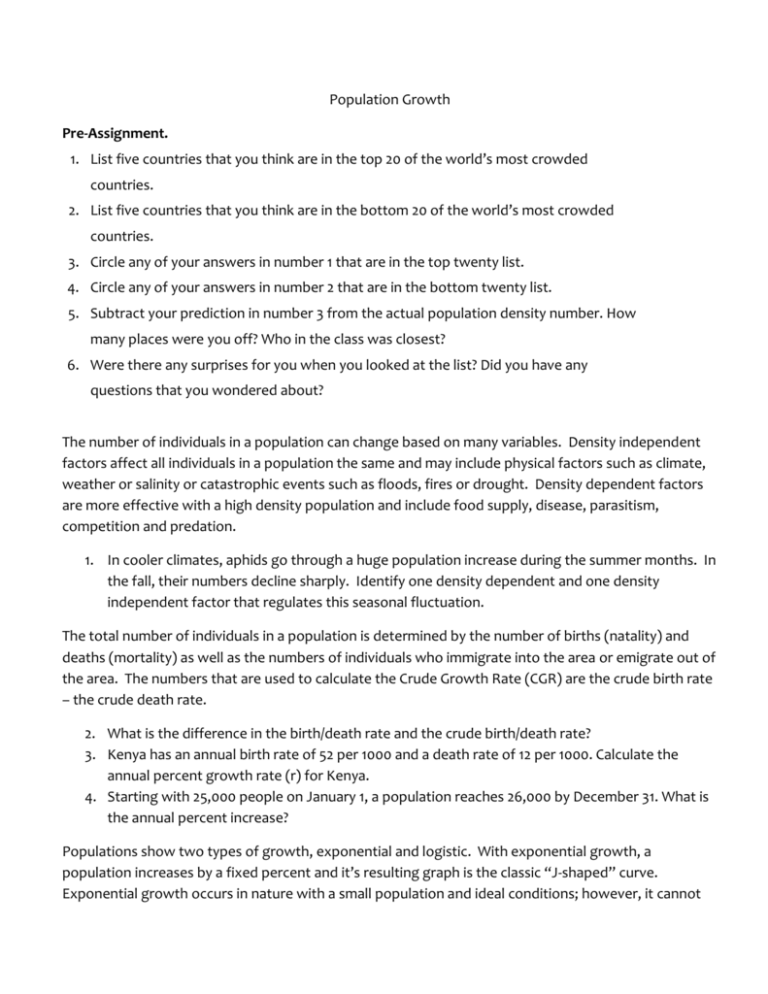
Population Growth Pre-Assignment. 1. List five countries that you think are in the top 20 of the world’s most crowded countries. 2. List five countries that you think are in the bottom 20 of the world’s most crowded countries. 3. Circle any of your answers in number 1 that are in the top twenty list. 4. Circle any of your answers in number 2 that are in the bottom twenty list. 5. Subtract your prediction in number 3 from the actual population density number. How many places were you off? Who in the class was closest? 6. Were there any surprises for you when you looked at the list? Did you have any questions that you wondered about? The number of individuals in a population can change based on many variables. Density independent factors affect all individuals in a population the same and may include physical factors such as climate, weather or salinity or catastrophic events such as floods, fires or drought. Density dependent factors are more effective with a high density population and include food supply, disease, parasitism, competition and predation. 1. In cooler climates, aphids go through a huge population increase during the summer months. In the fall, their numbers decline sharply. Identify one density dependent and one density independent factor that regulates this seasonal fluctuation. The total number of individuals in a population is determined by the number of births (natality) and deaths (mortality) as well as the numbers of individuals who immigrate into the area or emigrate out of the area. The numbers that are used to calculate the Crude Growth Rate (CGR) are the crude birth rate – the crude death rate. 2. What is the difference in the birth/death rate and the crude birth/death rate? 3. Kenya has an annual birth rate of 52 per 1000 and a death rate of 12 per 1000. Calculate the annual percent growth rate (r) for Kenya. 4. Starting with 25,000 people on January 1, a population reaches 26,000 by December 31. What is the annual percent increase? Populations show two types of growth, exponential and logistic. With exponential growth, a population increases by a fixed percent and it’s resulting graph is the classic “J-shaped” curve. Exponential growth occurs in nature with a small population and ideal conditions; however, it cannot be sustained indefinitely. The formula for predicting the size of a population is: N(t) = Noert where N(t) is the size of the population after time (t), No is the size of the original population and r is the rate of natural increase in decimal form. This is the same formula that the Rule of 70 is derived. When the population is doubled, then N(t) = 2No. And 2No=Noert ; and 2 = ert ; then ln(2) = rt; and, 0.690 = rt; and so therefore, if the rate is equal to 5%, then the doubling time is t = 0.69/r = 0.69/0.05 = 13.8 years! (Actually, the 0.69 was rounded to 0.7 to make the Rule of 70!) Because of Environmental Resistance, population growth decreases as density reaches carrying capacity. Carrying capacity (K) is the maximum number of individuals a habitat can support over a given period of time due to environmental resistance. The graph of individuals vs. time yields a sigmoid or S-curved growth curve. The maximum rate at which a population can increase is its biotic potential The biotic potential of a species is influenced by the age at which reproduction begins, the time the species remains reproductive, and the number of offspring produced during each period of reproduction. The growth of natural populations is more accurately depicted by the logistic growth equation rather than the exponential growth equation. In logistic population growth, the rapid increase in number peaks when the population reaches the carrying capacity and is calculated by the formula I = rN ( K - N / K) where I = the annual increase for the population, r = the annual growth rate, N = the population size, and K = the carrying capacity. 5. Starting with 25,000 people in 1966, the population of Escondido reached 75,000 by 1984. What is the percent increase for this 18 year period? If you project this enormous increase through the year 2001, it explains the gridlock on Highway 78. 6. Starting with 5 billion people in 1988, calculate the world population in the year 2100. 7. Some rather pessimistic demographers speculate that the maximum number of people that can be sustained by land agriculture is about 40 billion. This means that the carrying capacity (K) for the earth is 40 billion. Starting with a population of 5 billion in 1988, when will the earth reach 40 billion (in years)? 8. Under optimal conditions, Wolffia microscopica has a doubling time by budding of 30 hours (1.25 days). Calculate the growth rate (r) of W. microscopica per day. 9. Starting with one wolffia plant (with an average volume of one cubic millimeter), calculate the final population (N) at the end of 4 months (125 days). [This number is roughly equivalent to the volume of the earth in cubic millimeters!] 10. With six offspring per female (equal sex ratio) and an average generation interval of 20 years, how many total offspring could a couple theoretically produce in 60 years? [Assuming everyone in the family lives that long.] 11. Referring to the above question #10, how many total people would you have in 60 years if the generation interval was increased to 30 years? [Everyone would need to wait a little longer to have their kids.



